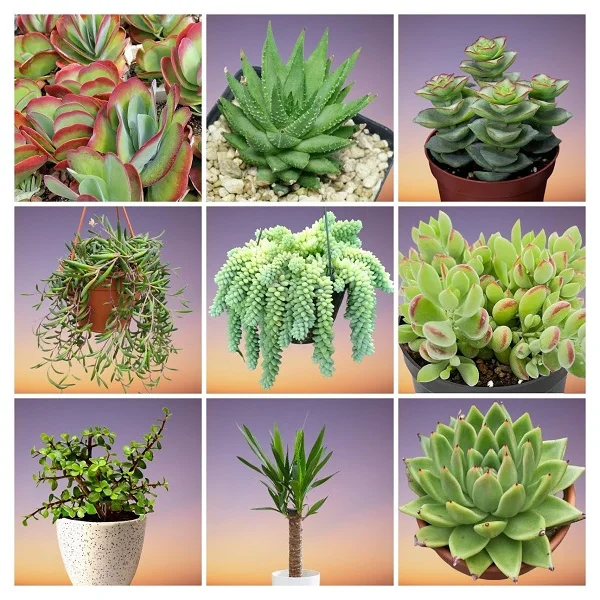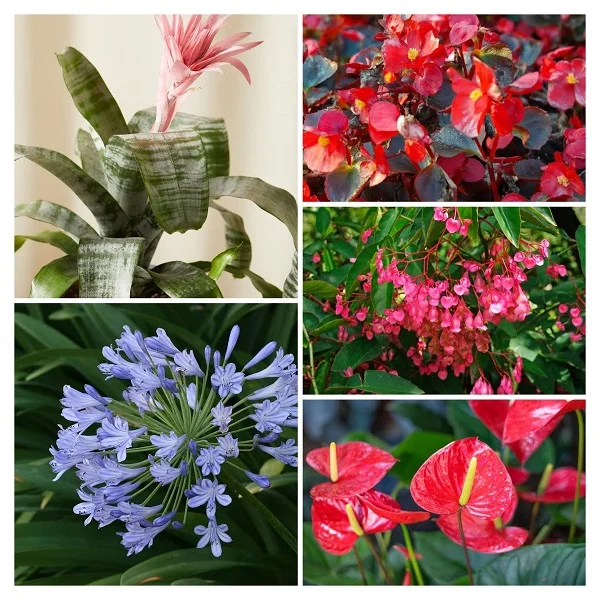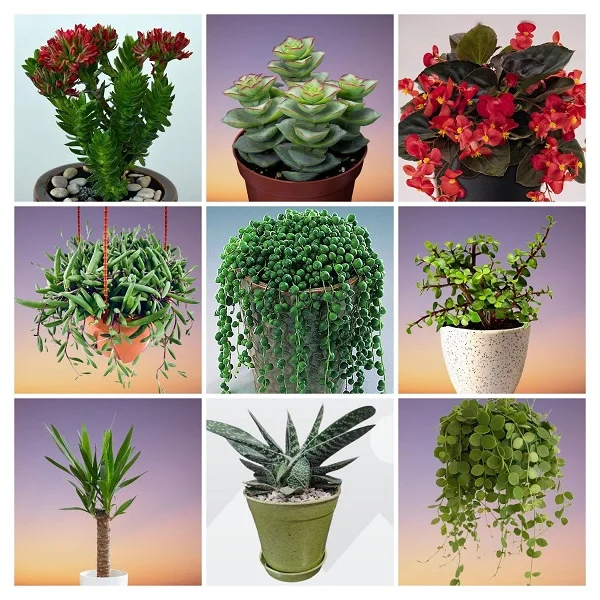29 Low Maintenance Plants for a Sunny Balcony | Plants that Thrive in a Sunny Balcony
Some links in this post may be affiliate links
Low-maintenance plants for a sunny balcony are sun loving plants that require some direct sunshine to thrive and flourish. Flowering plants are perfect for dressing a sunny balcony.
The plants can be potted in containers, flowerboxes or hanging baskets. Vining plants can also be grown on a trellis or a pole to create a dramatic effect.
To cosy up a sunny balcony go for plants with contrasting striking colours, texture and sizes. Mix foliage plants with flowering plants for a spectacular sight to behold.
We have outlined herebelow 29 low maintenance plants (plus their care guides) that are perfect for a sunny balcony you can choose from.
29 Best Plants for a Sunny Balconny
Our choice of the best plants for a sunny balcony include Bird of Paradise Plant, Bougainvillea Plant, Paddle Plant, Chinese Hibiscus, Bush Lily, Geraniums, African Fig Tree, Snake Plant, Wax Begonia, Sunglow Plant, Spineless Yucca among others.
1. Bird of Paradise Plant (Strelitzia reginae)
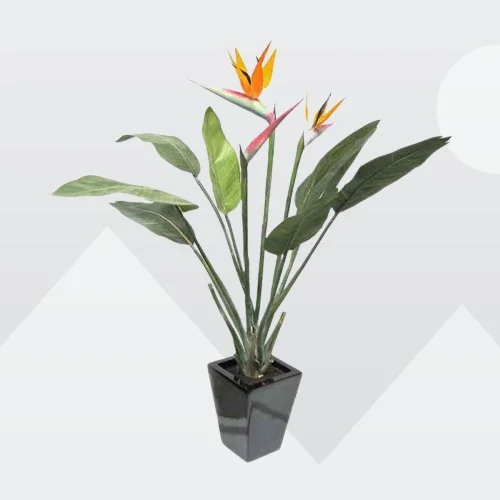
Bird of Paradise Plant or Crane Flower is a spectacular flowering plant with vivid bright orange and blue flowers borne on top of tall stalks and surrounded by large leaves.
The Crane Flower Plant grows to a height of about 5-7 feet and 3-4 feet wide. The evergreen leaves are arranged in two ranks, making a fan-shaped crown.
Strelitzia reginae grows best in bright light with some direct sunshine, average warmth, humid conditions and consistently moist, fertile, well-drained soil.
Learn more on how to grow and care for Bird of Paradise Plant (Strelitzia reginae)
2. Bougainvillea Plant (Bougainvillea glabra)

Bougainvillea Plant or Paper Flower is a popular flowering indoor plant which is grown for the showy blooms as a shrub, as a hanging basket plant, as a bonsai or allowed to climb on a trellis.
There are many hybrids of Bougainvillea where the most popular are the large-leaved, large-flowered Mrs Butt whose flowers are rose-crimson, Magnifica which is purple, Raspberry Ice whose flowers are a ravishing red, Alexendra which is pink among others.
Bougainvillea glabra thrives in very bright light with some direct sunlight, average warmth, average humidity and moderately moist, fertile, well-drained soil.
Learn how to grow and care for Bougainvillea Plant (Bougainvillea glabra)
3. Paddle Plant (Kalanchoe thyrsiflora)

Kalanchoe thyrsiflora also called Desert Cabbage, FlapJack or White Lady is among the popular Kalanchoe varieties on account ot its beautiful foliage.
FlapJack Kalanchoe forms a basal rosette of large, rounded, succulent, stalkless leaves which are grayish-green with red margins under bright light, covered with a white powdery bloom.
Paddle Plant flourishes in bright light to full sunlight, average warmth of 16-260C, moderate humidity of 50-55% and moderately moist, rich, well-drained, succulents soil coupled with monthly feeding in the growing season.
Read more on how to grow and care for Paddle Plant (Kalanchoe thyrsiflora)
4. Chinese Hibiscus (Hibiscus rosa-sinensis)
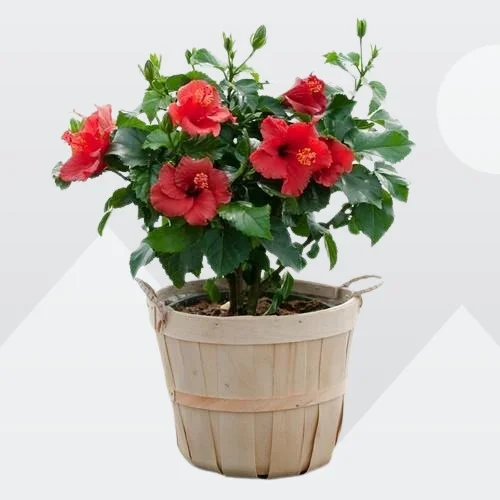
Chinese Hibiscus also called Tropical Hibiscus, Rose of China or Shoeblackplant is a popular flowering indoor plant on account of its large, ruffled, trumpet-shaped blooms which come in many vibrant colors.
With proper care, Rose of China will produce a succession of papery flowers in early spring to late fall which come in red, white, yellow , pink, orange, purple, peach and may be single, double or semi-double.
Hibiscus rosa-sinensis thrives in bright light with 6-8 hours of direct sunlight, average warmth and humidity and consistently moist, fertile, well-drained soil.
Learn more on how to grow and care for Chinese Hibiscus (Hibiscus rosa-sinensis)
5. Bush Lily (Clivia miniata)
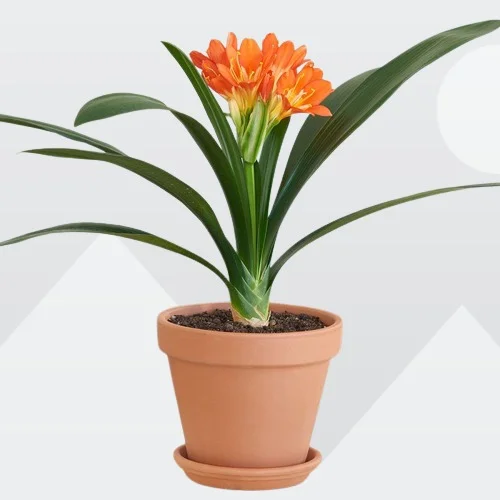
Bush Lily also called Natal Lily is an easy care flowering plant which bears large clusters of flowers and easily adapts to indoor growing conditions.
Natal Lily is a sensitive plant which does not like to be disturbed therefore, don't move the plant when in bud or flower and don't repot unless the plant is pushing out of the container.
Clivia miniata grows best in bright light with 4-6 hours of direct sunlight, warm conditions and moderately moist, rich, well-drained soils.
Read more on how to grow and care for Bush Lily (Clivia miniata)
6. Geraniums (Pelargonium x hortorum)
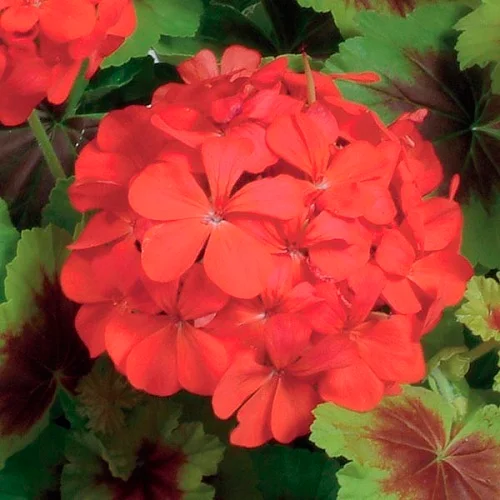
Geraniums are popular plants due to their ease of care, large colourful blooms and a long flowering period; will bloom almost all year-round if kept on a sunny window at average room temperature.
Geraniums like Cigar Plant (Cuphea ignea) are grown for their colourful foliage and large flowers which are spectacular in any space.
Pelargonium x hortorum thrives in bright light with some direct sunlight, cool to average warmth, average room humidity and consistently moist, fertile, well-drained soil.
Learn more on how to grow and care for Geraniums (Pelargonium x hortorum
7. African Fig Tree (Ficus cyathistipula)
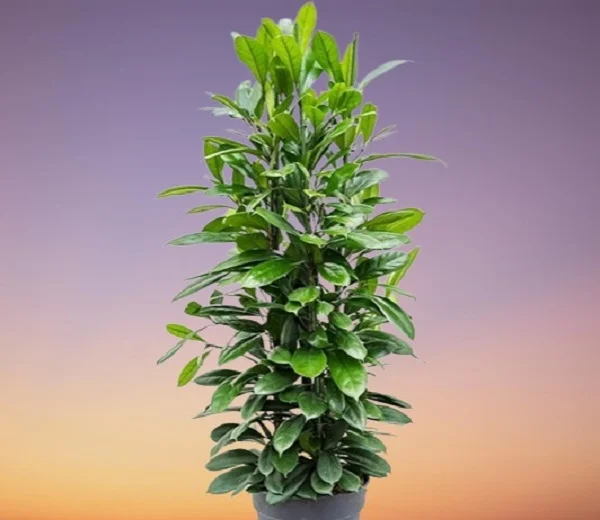
Ficus cyathistipula commonly called African Fig Tree or Birchbark Fig is an evergreen, vigourously growing shrubby plant with glossy, leathery, tumbler-shaped, dark-green leaves arranged spirally on a 4 cm long petiole.
African Fig Tree has a thin trunk, which branches readily and may have adventitious roots. The leaves clothe the upright stems all through the year. It has a dark and flaky bark which gives it the common name, 'Birchbark Fig'.
African Fig Tree (Ficus cyathistipula) flourishes in bright light with 4-6 hours of direct sunlight, average warmth of 16-240C, moderate humidity of 50-55% and moderately moist, rich, well-drained, all purpose soil coupled with fortnightly feeding during the growing season.
Read more on how to grow and care for African Fig Tree (Ficus cyathistipula)
8. Wax Begonia (Begonia semperflorens)

Begonia semperflorens is one of the popular Begonia varieties on accounts of its vibrant blooms, striking waxy foliage and ability to adapt to a wide range of growing conditions. It is one of the easiest of the flowering Begonias.
There are many Wax Begonia hybrids with a wide range of flower types in red, white, orange and pink. Newer hybrids are regularly developed which are more compact and have bigger blooms.
Begonia semperflorens thrives in bright, indirect light with 4-6 hours of direct sunshine, moderate warmth of 18-270C, above average humidity of 60-70% and moderately moist, rich, well-drained, all purpose soil coupled with fortnightly feeding during the growing season.
Learn more on how to grow and care for Wax Begonia (Begonia semperflorens)
9. Sunglow Plant (Crassula coccinea)
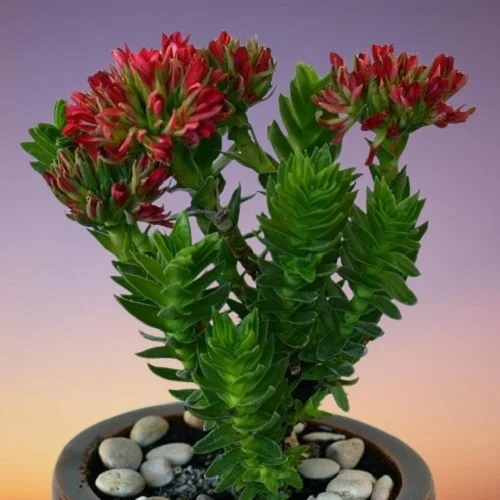
Crassula coccinea commonly called Sunglow Plant or Red Crassula is among the popular Crassula varieties whose stems are clothed with leathery triangular leaves and look like they are stacked on top of each other. It bears showy clusters of red tubular flowers
Sunglow Plant and its cousins Crassula ovata (Jade Plant), Crassula elegans (Elegant Crassula) and Crassula capitella 'Campfire' (Crassula Campfire) are some of the colorful plants for a sunny balcony.
Crassula coccinea thrives in bright light with 4-6 hours of direct sunlight, moderate warmth of 15-240C, humidity of 50-55% and moderately moist, fertile, well-drained, succulents soil coupled with monthly feeding during the growing season.
Read more on how to grow and care for Crassula coccinea (Sunglow Plant)
10. Spineless Yucca (Yucca gigantea)
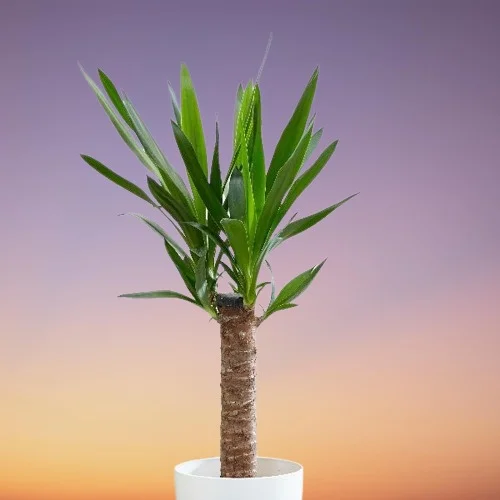
Spineless Yucca also called Blue-stem Yucca, Giant Yucca or Yucca Cane bears a crown of long, leathery, strap-like, spineless leaves and white bell-shaped flowers may appear on mature plants.
The Blue-stem Yucca requires a deep, well-drained container and a well-lit spot with some sunshine inorder to thrive. It can grow in a variety of soils and is drought-tolerant.
Yucca gigantea thrives in very bright light with 4-6 hours of direct sunlight, average warmth and humidity and moderately moist, fertile succulent soil.
Learn more on how to grow and care for Spineless Yucca (Yucca gigantea)
11. Croton Plants (Codiaeum variegatum)
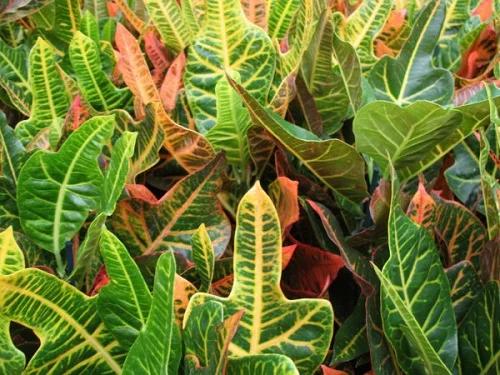
Croton Plant also called Joseph's Coat is a popular plant on account of its vivid foliage colors and varied leaf shapes.
Most Croton varieties have Laurel-like foliage, but there are also forked leaves, long ribbons, lobed leaves, twisted and curled types. Their identification is not easy.
Crotons require bright light with some direct morning or evening sunlight, warm and humid conditions and consistently moist, rich, well-drained soil to thrive.
Read more on how to grow and care for Croton Plants (Codiaeum variegatum)
12. Snake Plants (Dracaena trifasciata)

Snake Plant also called Mother in-law's Tongue is a popular plant for the home on account of its long beautifully colored foliage and ability to clean indoor air.
The Mother-in-law's Tongue Plants are hard to kill plants which can withstand low light, dry air, drafts and periods without water but are prone to root-rot in soggy soil.
Dracaena trifasciata thrives in bright light with some direct sunlight, average warmth and moderately moist, loose, fertile, Cactus and Succulents soil.
Learn more on how to grow and care for Snake Plants (Dracaena trifasciata)
13. Desert Cacti
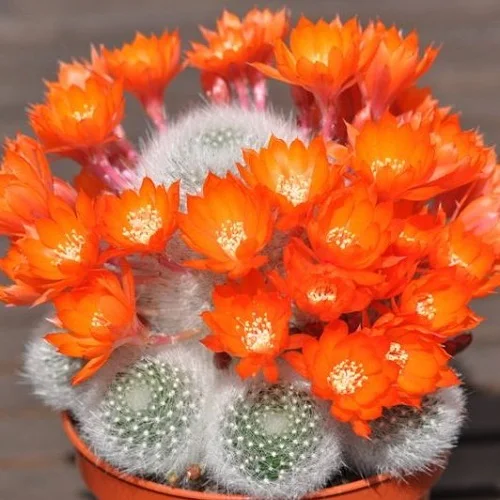
Desert Cacti come in numerous forms and sizes and they form interesting plants which are especially popular with beginners as they can tolerate some level of neglect.
The native habitat of Desert Cacti is subject to drought; many live in extremely dry environments like the Atacama Desert with very bright sunlight.
Desert Cacti require bright light to full sunlight with at least 2-3 hours of sunshine per day, average warmth and humidity and moderately moist, well drained soil.
Read more on how to grow and care for Desert Cacti
14. Thread Agave (Agave filifera)
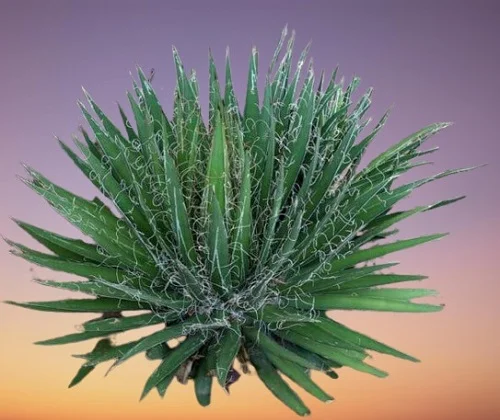
Thread Agave also called Thread-leaf Agave is an evergreen perennial plant and is one of the popular Agave plants grown indoors for its compact size which forms a beautiful, stemless rosette of long, blade-like, dark-green to a bronzish-green colored leaves.
The Thread-leaf Agave is a slow growing plant which may take a long time to out grow its pot and therefore it does not require frequent repotting.
Agave filifera thrives bright light with 6-8 hours of direct sunlight and moderately moist, well-drained soil that is rich in organic matter.
Learn more on how to grow and care for Thread Agave (Agave filifera)
15. Ponytail Palm (Beaucarnea recurvata)
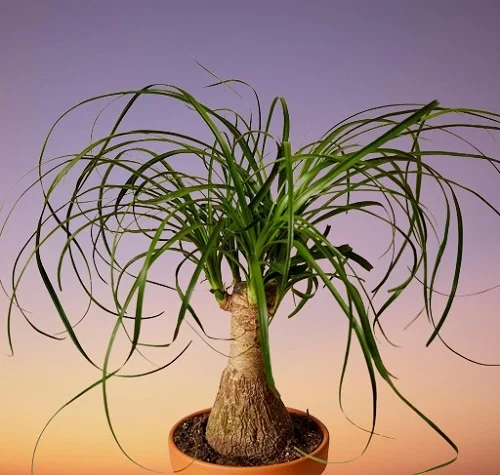
Ponytail Palm or Elephant Foot is an easy care plant that does not require a lot of attention which makes it ideal for a beginner or the forgetful plant parent.
The large, swollen bulb in Elephant Foot stores water which resembles an elephant's foot and a thin trunk topped by a plume of long strap-like leaves which give this plant its common name 'Ponytail Palm'.
Beaucarnea recurvata grows best in bright light with some direct sunlight, average warmth and moderately moist, rich, well-drained soil.
Read more on how to grow and care for Ponytail Palm (Beaucarnea recurvata)
16. Burro's Tail Plant (Sedum morganianum)
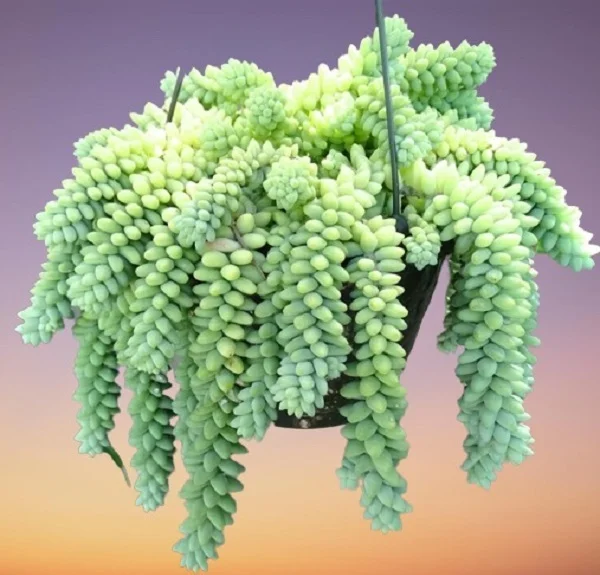
Burro's Tail Plant or Donkey's Tail Plant is a trailing plant which bears 2-3 ft long stems, completely clothed with blue-green cylindrical succulent leaves and is ideal for a hanging basket.
Donkey's Tail Plant grows well in very good light but not extreme heat. To enhance leaf coloration grow the plant in bright light with at least 8 hours of sunshine.
Sedum morganianum thrives in bright light with some direct sunshine, average warmth and moderately moist, fertile, loose, Cactus and Succulents soil.
Learn more on grow and care for Burro's Tail Plant (Sedum morganianum)
17. Sago Palm (Cycas revoluta)
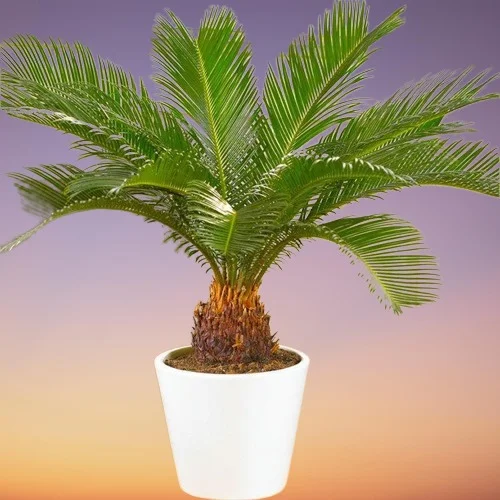
Sago Palm also called King Sago, Sago Cycad or Japanese Sago Palm is a slow-growing, drought-tolerant plant which bears an attractive dark-green rosette of stiff arching foliage.
The leaves in Sago Cycad grow out into a feather-like rosette. The leaflets are stiff and have strongly recurved or revolute edges. The trunk is characterized by a thick coat of fibers and can branch several times to produce multiple heads of leaves.
Cycas revoluta prefers medium to bright light with some direct sunlight, average warmth and humidity and moderately moist, rich, well-drained soil.
Read more on how to grow and care for Sago Palm (Cycas revoluta)
18. Fiddle Leaf Fig (Ficus lyrata)
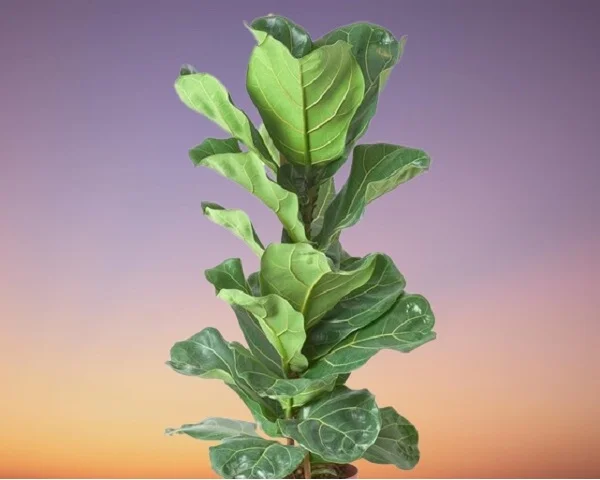
Fiddle Leaf Fig is a popular indoor plant due to its large, striking, violin-like leaves with a leathery texture, prominent veins and a wavy margin which is perfect for large spaces.
The Fiddle Leaf Fig is relatively tough and can grow to a height of 6-10 feet when grown indoors. The leaves are about 1.5 feet long.
Ficus lyrata grows best in bright light with 4-6 hours of direct sunlight, warm and humid conditions and moderately moist, fertile, well-drained soil.
Learn more on how to grow and care for Fiddle Leaf Fig (Ficus lyrata)
19. African Lily (Agapanthus africanus)
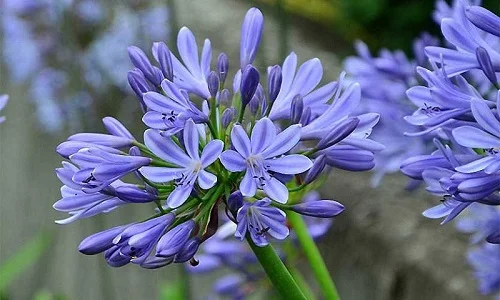
African Lily or Lily of the Nile bears large round heads of beautiful tubular flowers on long stalks which appear in succession through out the growing season.
The main flower color in Lily of the Nile is blue but there is a white-flowered cultivar, Albus. It also has varieties that are pink and violet.
Agapanthus africanus thrives in bright light with some direct sunlight and consistently moist, rich, well-drained soil.
Read more on how to grow and care for African Lily (Agapanthus africanus)
20. Haworthia Plants
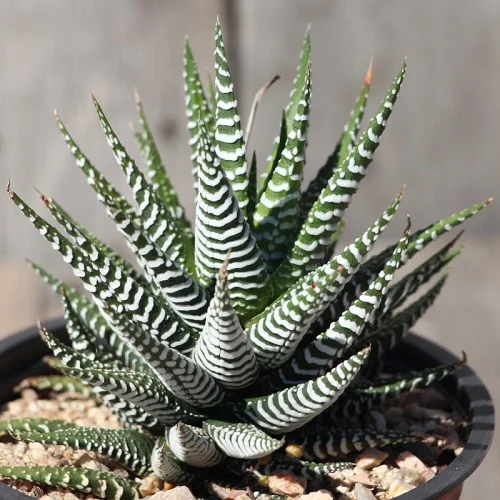
Haworthia Plants have firm, tough, fleshy leaves, usually dark-green in color while others are softer and contain leaf windows with translucent panels through which sunlight can reach internal photosynthetic tissues.
The Haworthia Plants form a rosette of leaves and the flowers are white and small. When the plants are stressed like when deprived of water, their color can change to reds and purple.
Haworthia grows best in bright light with 4-6 hours of direct sunlight, average to above average warmth and slightly moist, fertile, succulents soil.
Learn more on how to grow and care for Haworthia Plants
21. Mandevilla Plant
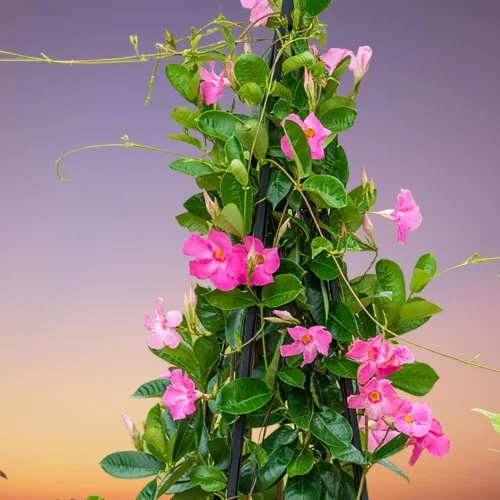
Mandevilla or Rocktrumpet bears glossy, dark-green oval leaves and brightly colored, large, trumpet-shaped flowers in white, pink, yellow, red or mixed colors.
The Rocktrumpet also called Dipladenia is native to the tropical regions of Southwestern United States, Mexico, Central America, the West Indies, and South America.
Mandevilla Plant thrives in bright light with some direct sunlight, warm and humid conditions, and consistently moist, rich, well-drained soil.
Read more on how to grow and care for Mandevilla Plant
22. Bluecrown Passionflower (Passiflora caerulea)
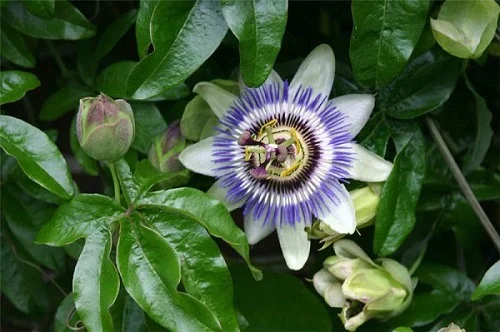
Bluecrown Passionflower also called Blue Passionflower, Southern Beauty, Wild Apricot, Jesus Flower or Passion Flower is a rampant climber bears fragrant blue-white flowers with a prominent fringe of filaments in bands of blue, white and brown.
If left unpruned, Blue Passionflower can become unruly. It is ideal for a trellis or a hanging basket where it can display its beautiful flowers and leaves.
Passiflora caerulea prefers bright light with some direct sunlight, cool to average warmth, humid conditions and consistently moist, fertile, free-draining soil.
Learn more on how to grow and care for Bluecrown Passionflower (Passiflora caerulea)
23. Aloe Plants
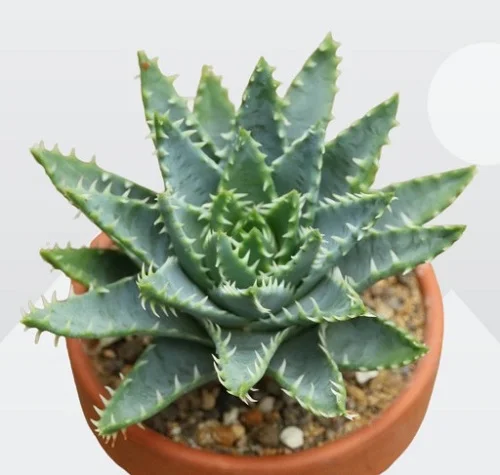
Aloe Plants are popular, succulent plants which come in all shapes and sizes. There are numerous species of Aloes but only a few are grown in the home.
The most common Aloe Plants include Aloe Vera (Aloe barbadensis), Aloe aristata (Lace Aloe), Aloe variegata (Partridge-breasted Aloe), Aloe jucunda, Aloe humilis (Hedgehog Aloe) and Aloe mitriformis.
Aloe Plants grow best in bright light with 4-6 hours of direct sunlight, average warmth away from drafts and moderately moist, rich, succulents soil.
Read more on how to grow and care for Aloe Plants
24. Echeveria Plants
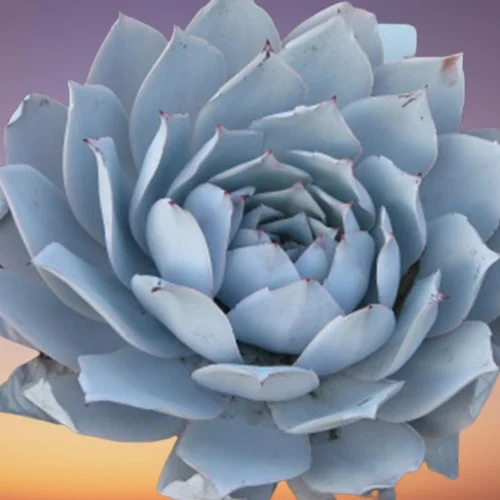
Echeveria Plants are low maintenance, easy to grow and propagate plants which form a rosette of short, beautiful and tightly packed leaves on short stems.
The popular Echeveria Varieties include Plush Plant (Echeveria harmsii), Echeveria amoena, Echeveria carnicolor, Peacock Echeveria (Echeveria desmetiana) and Painted Lady Echeveria (Echeveria derenbergii).
Echeveria Plants thrive bright light with 4-6 hours of direct sunlight, average warmth and moderately moist, well-drained soil.
Learn more on how to grow and care for Echeveria Plants
25. Ivy Geranium (Pelargonium peltatum)

Ivy Geranium also called Ivy-leaved Pelargonium, Cascading Geranium or Trailing Geranium is a scrambling plant with five shallowly or deeply lobed, circular to heart-shaped, glossy leaves and large, umbel-like inflorescences atop a long stalk.
The flowers in Ivy-leaved Pelargonium occur in clusters of white, pink, lavender, purple, orange, salmon, red, burgundy, bicolored or patterned and appear in spring through fall.
Pelargonium peltatum grows best in bright light to full sun, moderately warm and humid conditions, and moderately moist, rich, well-drained soil.
Read more on how to grow and care for Ivy Geranium (Pelargonium peltatum)
26. Pink Jasmine (Jasminum polyanthum)
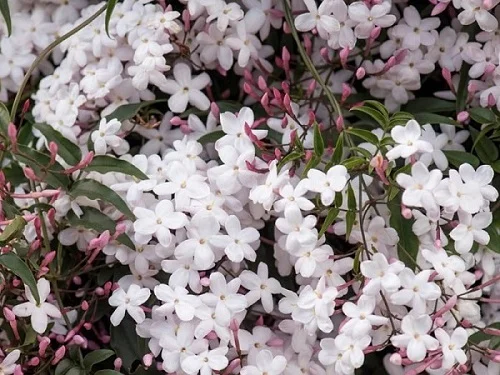
Pink Jasmine also called Winter Jasmine, Star Jasmine, French Perfume or Chinese Jasmine is a vigorously growing climbing flowering plant which bears fragrant flowers in clusters.
The eye-catching Star Jasmine is mainly grown for the characteristic fragrance of its flowers and for its ability to withstand pests and diseases infestations.
Jasminum polyanthum thrives in bright light with some direct sunlight, warm and humid conditions and consistently moist, rich, well-drained soil.
Learn more on how to grow and care for Pink Jasmine (Jasminum polyanthum)
27. Silver Dollar Jade (Crassula arborescens)
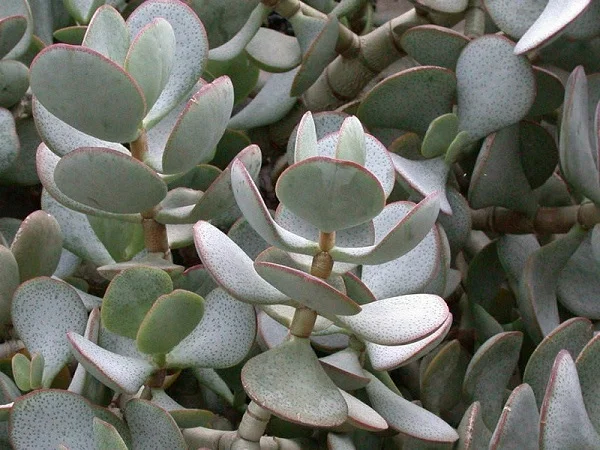
Silver Dollar Jade or Silver Dollar Plant is a perennial succulent shrub which bears rounded blue-gray leaves with maroon edges and small maroon speckles on the upper surface.
Silver Dollar Plant and its relatives Crassula perforata (String of Buttons Plant), Crassula brevifolia (Crassula pearsonii) and Crassula falcata (Propeller Plant) are among the best drought tolerant plants perfect for a sunny balcony.
Crassula arborescens prospers in bright light with 4-6 hours of direct sunlight, moderate warmth of 15-260C, humidity of 50-55% and moderately moist, rich, well-drained, succulents soil coupled with monthly feeding in the growing period.
Read more on how to grow and care for Silver Dollar Jade (Crassula arborescens)
28. Madagascar Jasmine (Stephanotis floribunda)
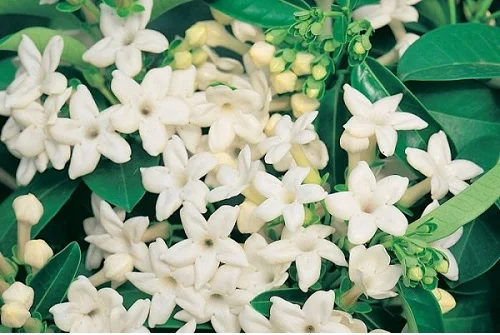
Madagascar Jasmine also called Hawaiian Wedding Flower, Bridal Wreath or Clustered Wax Flower is an evergreen, hardy, woody climber with glossy, dark-green, oval leaves.
The Hawaiian Wedding Flower is a vigorously growing plant which will flourish in a hanging basket or on a trellis where it can beautifully display the white, waxy, star-shaped, tubular, sweet-scented in spring through fall.
Stephanotis floribunda thrives in bright light with some morning or evening sunshine, warm and humid conditions and consistently moist well-drained soil that is rich in organic matter.
Learn more on how to grow and care for Madagascar Jasmine (Stephanotis floribunda)
29. String of Lemons Plant (Senecio citriformis)
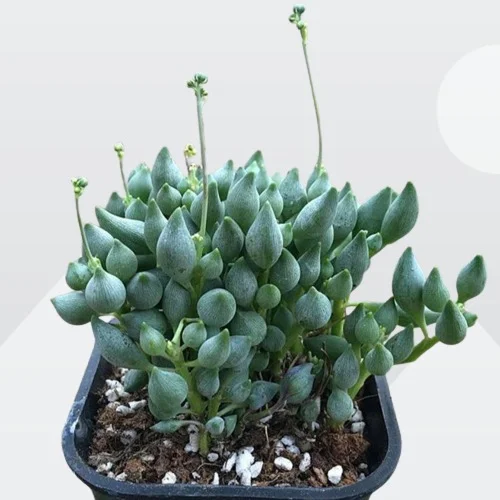
String of Lemons Plant also called String of Tears or String of Teardrops is among the popular Senecio plants varieties and bears erect stems on which grow oval, green to dark-green, teardrop-shaped or lemon-shaped leaves.
The leaves in String of Lemons Plant like in String of Pearls Plant (Senecio rowleyanus), String of Bananas Plant (Senecio radicans), String of Watermelons Plant (Senecio herreanus) and String of Dolphins Plant (Senecio peregrinus) have translucent windows which allow light to reach into the interior of the leaf where photosynthesis takes place.
Senecio citriformis flourishes in bright light with 4-6 hours of direct sunlight, moderate warmth of 20-270C, average humidity of 50-55% and moderately moist, fertile, well-drained, succulents soils coupled with regular feeding during the growing season.
Learn more on how to grow and care for String of Lemons Plant (Senecio citriformis)
